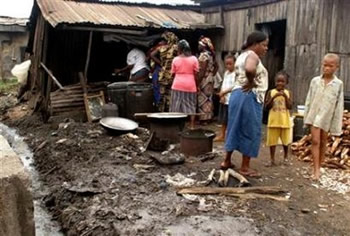Entered into the database on Friday, June 16th, 2006 @ 12:44:32 MST
The world's growing number of poor slum dwellers is a ticking time
bomb that governments dare not ignore, the United Nations said on Friday.
The world will pass a critical point in 2007 when the majority of its
6 billion people will be urbanized, the world body said. One-third of them will be slum dwellers, many trapped in poverty but overlooked
by governments and with no prospects of improvement. "When a critical mass of people are in one place, if you don't
empower them they will empower themselves through revolution," Anna Tibaijuka,
head of UN-HABITAT said in London, presenting the agency's State of the World's
Cities 2006/7 report. "If we want to avoid chaos we have to empower the poor people," she
told a news conference ahead of the third World Urban Forum meeting in Vancouver,
Canada, from June 19-23. Far from being better off than their rural cousins, the urban poor were in
many ways worse off, ignored by aid agencies and with little access to housing,
adequate sanitation, clean water, education or health services. For example, even the children of relatively affluent slum dwellers had higher
rates of killer diarrhea than poor children in the countryside, the report said,
noting that slum dwellers also tended to die young. Tibaijuka said the world's slum dwellers faced multiple disadvantages being
near to services, durable housing and the seat of political power but having
no access to any of them. This in turn led to rising divisions and tensions between the "haves"
and "have nots" in burgeoning towns and cities. In sub-Saharan Africa, 72 percent of the urban population live in slums, attracted
there by prospects of a better life but, once sucked in, are trapped in a cycle
of poverty, degradation and violence. By 2030, the urban population of Africa, the least urbanized continent, will
be larger than the total population of Europe, the U.N. report said. "The peace and stability of cities is in question if the majority are
in slums," Tibaijuka said, urging governments not to simply bulldoze them
as President Mugabe had done in Zimbabwe but to provide housing and services
for them. The report said that in seven African countries surveyed, Burkina Faso, Burundi,
Ghana, Kenya, Mali, Niger and Zambia, HIV/AIDS was more prevalent in the urban
than rural population. It also noted the rise of mega- and even metacities -- conurbations with populations
of more than 10 million and 20 million respectively -- saying nine percent of
the world's people now live in megacities against four percent in 1975. The trend is accelerating, the report said, noting that by 2030, nearly 4 billion
people, or 80 percent of the world's urban dwellers, will live in cities of
the developing world. ___________________ Read from Looking Glass News More Billionaires, More Poverty: Get Used To It Report: Poverty stalks Asian children Lies, Damn Lies and Poverty Statistics Poverty Facts and Stats

http://www.lookingglassnews.org/viewstory.php?storyid=296
http://www.lookingglassnews.org/viewstory.php?storyid=2161
http://www.lookingglassnews.org/viewstory.php?storyid=5201
http://www.lookingglassnews.org/viewstory.php?storyid=4020